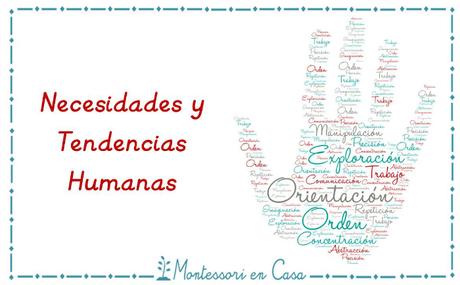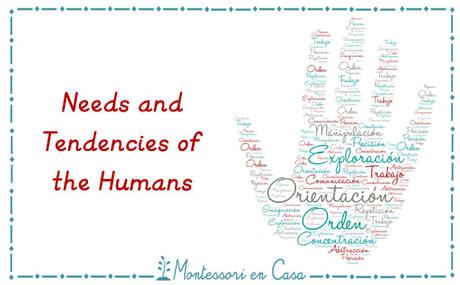

(scroll down for English)
Tal y cómo os prometí, hoy voy a hablaros sobre las necesidades y tendencias humanas, un tema importante de filosofía Montessori que os va a resultar interesante no sólo de cara a vuestra relación con los niños, sino también con los adultos.
Los seres humanos, y los animales en general, tenemos una serie de necesidades físicas: alimento, abrigo, refugio, protección/defensa... Pero los seres humanos además de esas necesidades físicas tenemos unas necesidades espirituales, no relacionadas con la surpervivencia sino con la búsqueda del significado de nuestra existencia.
Las tendencias humanas son las que nos guían para ayudarnos a satisfacer esas necesidades. Pero ¿qué es exactamente una tendencia?
- Una tendencia puede ser definida como una fuerza de accionamiento, que tiende en cierta dirección.
- Las tendencias humanas son comunes a todos los seres humanos, independientemente de su sexo, raza, cultura o de la época en la que vivan.
- Se manifiestan durante toda nuestra vida pero de diferente manera en cada plano del desarrollo.
Conocer las tendencias humanas y ser capaz de reconocer su manifestación en los niños es esencial para saber acompañar y no obstaculizar el desarrollo del ser humano. Maria Montessori habló de las tendencias humanas, pero nunca declaró un número exacto de ellas. Vamos a ver las más destacadas.
Exploración
La exploración es una inclinación a investigar, investigar, descubrir y mirar a nuestro alrededor. Esto implica el uso de los sentidos y el movimiento. Esta tendencia fue esencial para la supervivencia de los primeros seres humanos. A medida que la vida se vuelve más segura no dejamos de explorar pero lo hacemos más allá de los sentidos: exploramos a un nivel filosófico, emocional, creativo, artístico, espiritual...
Esta tendencia se manifiesta muy temprano en la vida del niño. Al principio, las áreas de exploración son limitadas y fuertemente ligadas a los sentidos. A medida que el niño va madurando se van ampliando sus horizontes de exploración.
Manipulación
Los seres humanos necesitan tocar y manipular su entorno para entenderlo. Es el siguiente paso después de la exploración: una vez que encontramos algo interesante, es natural querer usarlo de alguna manera. Así es como nació el concepto de "herramientas".
Orientación
La palabra orientación viene de oriente, por donde sale el sol. Es la capacidad de conocer nuestra situación en relación a nuestro entorno, tanto físico, emocional, intelectual o social. La orientación nos da una sensación de seguridad.
Esta tendencia también es muy notable en la primera infancia, cuando el niño está tratando de establecer puntos de referencia en un mundo nuevo y extraño.
Orden
El orden nos permite relacionar cosas y experiencias entre sí según su función, secuencia, características... El orden externo es esencial para el niño de 0 a 6 años porque está absorbiendo el medio ambiente directamente en la estructura de su cerebro. Una vez establecido ese orden interior somos capaces de mantener el orden en nuestro entorno de una manera más flexible y de hacer frente al desorden sin que nos suponga un problema.
Observación
La observación es necesaria para entender nuestro entorno con precisión y tomar decisiones correctas. Es un requisito clave para cualquier experimentación y es vital para la investigación científica.
Los niños son extremadamente observadores desde el nacimiento, absorbiendo todos los detalles de su entorno.
Abstracción / Imaginación
Esta es verdaderamente la característica que nos diferencia de los animales. Somos capaces de visualizar eventos que todavía no han ocurrido; somos capaces de sentir y expresar emociones que no son tangibles. Podemos imaginar algo que sólo existe en nuestra mente y, a continuación, buscar la manera de convertirlo en realidad.
Esta tendencia se empieza a manifestar especialmente a partir de los 6 años, en el segundo plano del desarrollo.
Concentración
Tenemos la capacidad de fijar nuestra atención en algo durante un periodo prolongado de tiempo, y al hacerlo, podemos llegar a ser resistentes a la distracción. Esta fijación de la atención es la primera condición necesaria para el aprendizaje.
Trabajo
El trabajo conduce a una sensación de logro y autoestima. Maria Montessori creía que a través del trabajo es como un niño construye su verdadero ser.
Repetición
Los niños tienen en su interior una necesidad de repetir ciertas tareas una y otra vez. Cuando un niño repite una determinada actividad puede alcanzar una gran concentración. Esto conduce no sólo al dominio de la tarea, sino también a una mayor capacidad de concentración y de un sentido de logro.
Precisión
Con el fin de obtener un resultado exitoso, es necesaria una cierta precisión. Los seres humanos han creado durante su evolución miles de técnicas y movimientos, cada uno de los cuales necesita cierta precisión para obtener el resultado deseado, ya se trate de hacer fuego, fabricar herramientas, tocar un instrumento, escribir...
Comunicación
Los seres humanos se deleitan en la transmisión de pensamientos, sentimientos e información entre ellos. La comunicación incluye la palabra escrita y hablada, el tacto, las expresiones faciales, los gestos, el arte, la música y la danza. La comunicación es el enlace de entendimiento entre las personas, tanto cara a cara como de generación en generación.
El control de error que conduce a la perfección
Esta tendencia aúna todas las demás. El niño explora su entorno y se dirige a un determinado material o tarea. Manipula los materiales. Se imagina el resultado que quiere conseguir. Repite las manipulaciones buscando orden y precisión. Él mismo controla sus errores al notar imperfecciones. Continúa trabajando, concentrado, luchando por la "perfección." Es importante tener en cuenta que esta idea de la perfección está en la mente del niño, no es algo impuesto por un padre o un maestro. Los niños experimentan un profundo sentimiento de satisfacción y alegría cuando se les permite trabajar hasta que hayan logrado lo que ellos consideran que es la perfección.
Por si quieres profundizar más en este tema, en 1956 Mario Montessori dió una conferencia en Holanda acerca de las tendencias, que después ha sido impresa en forma de folleto por AMI con el título The Human Tendencies and Montessori Education.
¿Te habías parado a pensar en todas estas tendencias humanas? ¿Ahora que las has visto enumeradas, las identificas en las conductas de tus hijos y tus propias conductas? ¡Cuéntamelo en los comentarios!
¿Te ha gustado? ¡Compártelo! 🙂


As I promised, today I will tell you about needs and tendencies of the humans, an important theme in Montessori philosophy that I'm sure you will find interesting not only for your relationship with children, but also with adults.
Humans, and animals in general, have a number of physical needs: food, shelter, protection/defense... But humans, in addition to these physical needs have also spiritual needs, not related to survival but to the search for the meaning of our existence.
Human tendencies are what guide us to help us meet those needs. But what exactly is a tendency?
- A tendency can be defined as a driving force, which tends to a certain direction.
- Human tendencies are common to all human beings, whatever their gender, race, culture or time in which they live.
- They manifest throughout our lives but differently in each plane of development.
Knowing human tendencies and being able to recognize their manifestation in children is essential to know how to nurture and not hinder the development of human beings. Maria Montessori spoke of human tendencies, but never stated an exact number of them. Let's see the most important:
Exploration
Exploration is an inclination to investigate, investigate, discover and look around. This involves the use of the senses and movement. This tendency was essential to the survival of early humans. As life becomes safer we don't stop exploring but we do beyond the senses to explore at a philosophical, emotional, creative, artistic, spiritual level...
This tendency is manifested very early in the child's life. At first exploration areas are limited and strongly linked to the senses. As the child matures they she expands her horizons of exploration.
Handling
Humans need touch and manipulate their environment to understand it. It is the next step after exploring: Once you find something interesting, it is natural to want to use it in some way. This is how the concept of "tools" was born.
Orientation
The word comes from orient meaning east, where the sun rises. Is the ability to know our situation regarding our environment, both physical, emotional, intellectual or social. The orientation gives us a sense of security.
This trend is also very noticeable in early childhood, when the child is trying to establish references in a strange new world.
Order
Order allows us to relate things and experiences with each other according to their function, sequence features... External order is essential for the child from 0 to 6 because the environment is absorbed directly into the structure of his brain. Once we have established internal order we are able to maintain order in our environment in a more flexible way and to deal with the lack of order.
Observation
Observation is necessary to accurately understand our environment and make correct decisions. It is a key requirement for any experimentation and is vital for scientific research.
Children are extremely good observers from birth, absorbing every detail of their environment.
Abstraction / Imagination
This is truly the characteristic that differentiates us from other animals. We are able to visualize events that have not yet occurred; we are able to feel and express emotions that are not tangible. We can imagine something that exists only in our mind and then find a way to make it happen.
This tendency begins to manifest especially from 6 years old, in the second plane of development.
Concentration
We have the ability to fix our attention on something for a long period of time, and in doing so, we can become resistant to distraction. This is the first necessary condition for learning.
Work
Work leads to a sense of accomplishment and self-esteem. Maria Montessori believed that through work is like a child builds his true self.
Repetition
Children have within them a need to repeat certain tasks over and over again. When a child repeats a particular activity can reach a high concentration. This leads not only to the mastery of the task, but also to greater concentration and a sense of accomplishment.
Precision
In order to obtain a successful result, some precision is required. Humans have created during their evolution thousands of techniques and movements, each of which requires some precision to obtain the desired result, whether to fire, make tools, play an instrument, write ...
Communication
Human beings delight in the transmission of thoughts, feelings and information between them. Communication includes the written and spoken word, touch, facial expressions, gestures, art, music and dance. Communication is the link of understanding between people, both face to face and from generation to generation.
Error control that leads to perfection
This tendency combines all the others. The child explores his environment and is atracted to a particular material or task. She manipulates the materials. She imagines the result she wants to achieve. Repeats manipulations looking for order and precision. She controls her mistakes noticing imperfections. She keeps working, focused, striving for "perfection." It is important to note that this idea of perfection is in the child's mind, not something imposed by a parent or teacher. Children experience a deep sense of satisfaction and joy when they are allowed to work until they have achieved what they consider to be perfection.
If you want to delve deeper into this subject, in 1956 Mario Montessori gave a conference in the Netherlands about trends, which has since been printed in booklet form by AMI as " The Human Tendencies and Montessori Education".
Had you ever thought about all these human tendencies? Now that you've seen them listed, can you identify them in in your children behaviors and in your own?
Did you enjoy this post? Share it! 🙂
(Visited 160 times, 1 visits today)

